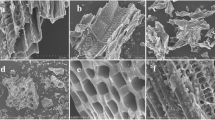Abstract
A series of gramine modified montmorillonites (gramine-MMTs) were prepared and characterized by thermogravimetric analysis, X-ray diffraction and zeta potential measurements. These modified clays with various amounts of gramine all exhibited higher removal efficiencies of both Chattonella marina and Alexandrium tamarense than did natural clay. With the augmentation of gramine content in the modified clays, the removal efficiency increased. The 24 h LC50 values of gramine-MMT with 12.68 % of gramine on C. marina and A. tamarense were 9.16 and 10.21 mg L−1, respectively. These data suggest gramine-MMT might be a promising material to remediate harmful algal blooms.

Similar content being viewed by others
References
Cai QN, Han Y, Cao YZ, Hu Y, Zhao X, Bi JL (2009) Detoxification of gramine by the cereal aphid Sitobion avenae. J Chem Ecol 35(3):320–325
Fusetani N (2004) Biofouling and antifouling. Nat Prod Rep 21:94–104
Guenther M, Bozelli R (2004) Effects of inorganic turbidity on the phytoplankton of an Amazonian Lake impacted by bauxite tailings. Hydrobiologia 511(1):151–159
Gustafsson S, Hultberg M, Figueroa RI, Rengefors K (2009) On the control of HAB species using low biosurfactant concentrations. Harmful Algae 8:857–863
Han MY, Kim W (2001) A theoretical consideration of algae removal with clays. Microchem J 68:157–161
Janèula D, Maršálek B (2011) Critical review of actually available chemical compounds for prevention and management of cyanobacterial blooms. Chemosphere 85:1415–1422
Kozak M, Domka L (2004) Adsorption of the quaternary ammonium salts on montmorillonite. J Phys Chem Solids 65(2–3):441–445
Laue P, Bährs H, Chakrabarti S, Steinberg CEW (2014) Natural xenobiotics to prevent cyanobacterial and algal growth in freshwater: contrasting efficacy of tannic acid, gallic acid, and gramine. Chemosphere 104:212–220
Lee YJ, Choi JK, Kim EK, Youn SH, Yang EJ (2008) Field experiments on mitigation of harmful algal blooms using a Sophorolipid–Yellow clay mixture and effects on marine plankton. Harmful Algae 7(2):154–162
Li L, Pan G (2013) A universal method for flocculating harmful algal blooms in marine and fresh waters using modified sand. Environ Sci Technol 47:4555–4562
Liang JJ, Li YH, Liu F, Li HY, Liu JS, Yang WD (2015) Experimental removal of Alexandrium tamarense cells using sulfobetaines and their modified clays. J Appl Phycol 27(6):2313–2319
Morrill LC, Loeblich AR (1983) Ultrastructure of the dinoflagellate amphiesma. Inter Rev Cytol 82:151–180
Nakashima T, Kim D, Miyazaki Y, Yamaguchi K, Takeshita S, Oda T (2006) Mode of action of an antialgal agent produced by a marine gammaproteobacterium against Chattonella marina. Aquat Microb Ecol 45:255–262
Pan G, Zou H, Chen H, Yuan XZ (2006) Removal of harmful cyanobacterial blooms in Taihu Lake using local soils. III. Factors affecting the removal efficiency and an in situ field experiment using chitosan-modified local soils. Environ Pollut 141(2):206–212
Park SC, Lee JK, Kim SW, Park Y (2011) Selective algicidal action of peptides against harmful algal bloom species. PLoS ONE 6(10):e26733
Pierce RH, Henry MS, Higham CJ, Blum P, Sengco MR, Anderson DM (2004) Removal of harmful algal cells (Karenia brevis) and toxins from seawater culture by clay flocculation. Harmful Algae 3(2):141–148
Sengco MR (2009) Prevention and control of Karenia brevis blooms. Harmful Algae 8(4):623–628
Sengco MR, Anderson DM (2004) Controlling harmful algal blooms through clay flocculation. J Eukaryor Microbiol 51(2):169–172
Sun XX, Han KN, Choi JK, Kim EK (2004) Screening of surfactants for harmful algal blooms mitigation. Mar Pollut Bull 48:937–945
Wu T, Yan XY, Cai XA, Tan SZ, Li HY, Liu JS, Yang WD (2010) Removal of Chattonella marina with clay minerals modified with a gemini surfactant. Appl Clay Sci 50(4):604–607
Acknowledgments
This work was supported by the National Natural Science Foundation of China (41176088), the Technical Extension Special Project of Guangdong Marine Fisheries Service (A201201K01), the Science and Technology Projects of Guangdong Province (2009B030803042) and Guangzhou Environmental Protection Project (2008-07).
Author information
Authors and Affiliations
Corresponding author
Rights and permissions
About this article
Cite this article
Liu, Sl., Wang, Ww., Liu, F. et al. Removal of Two Species of Harmful Algae Using Gramine Modified Montmorillonite. Bull Environ Contam Toxicol 96, 540–543 (2016). https://doi.org/10.1007/s00128-016-1758-y
Received:
Accepted:
Published:
Issue Date:
DOI: https://doi.org/10.1007/s00128-016-1758-y




